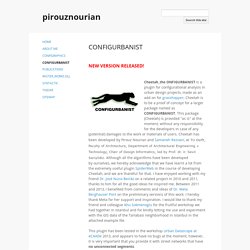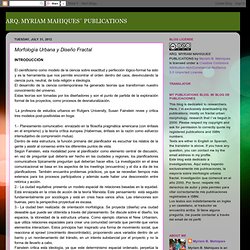

LOVE YOU SO MAT. Pagina de inicio n'UNDO Español. 10 STORIES OF COLLECTIVE HOUSING. Graphical analysis of inspiring masterpieces by a+t architecture publishers. CONFIGURBANIST - pirouznourian. Cheetah_the ONFIGURBANIST is a plugin for configurational analysis in urban design projects, made as an add on for grasshopper; Cheetah is to be a proof of concept for a larger package named as CONFIGURBANIST.

This package (Cheetah) is provided "as is" at the moment, without any responsibility for the developers in case of any (potential) damages to the work or materials of users. Cheetah has been developed by Pirouz Nourian and Samaneh Rezvani, at TU Delft, Faculty of Architecture, Department of Architectural Engineering + Technology, Chair of Design Informatics, led by Prof. dr. ir.
Sevil Sariyildiz. Although all the algorithms have been developed by ourselves, we hereby acknowledge that we have learnt a lot from the extremely useful plugin SpiderWeb in the course of developing Cheetah, and we are thankful for that. I have enjoyed working with my friend Dr. This is still a preliminary version, which includes a non-efficient Betweenness algorithm.
8 Cities That Show You What the Future Will Look Like. Cities used to grow by accident.

Sure, the location usually made sense—someplace defensible, on a hill or an island, or somewhere near an extractable resource or the confluence of two transport routes. But what happened next was ad hoc. The people who worked in the fort or the mines or the port or the warehouses needed places to eat, to sleep, to worship. Infrastructure threaded through the hustle and bustle—water, sewage, roads, trolleys, gas, electricity—in vast networks of improvisation. You can find planned exceptions: Alexandria, Roman colonial towns, certain districts in major Chinese cities, Haussmann’s Paris.
At least, that’s the way things worked for most of human history. WHY DENSITY? Debunking the myth of the cubic watermelon by a+t architecture publishers. Uneven Growth. HOME : rufwork. Manifiesto para un “Nuevo urbanismo acorde al siglo XXI”, by Reyes Gallegos Rodríguez. Imagen del barrio de El Puche, en Almería El urbanismo ha impuesto no sólo el medio donde las personas se mueven, sino también el modo de vida que se les establece.

El modo de producir y planificar ha supuesto un método de generación de las plusvalías necesarias al amparo de la legislación para la financiación del Estado de Bienestar, controlando los deseos de la población hacia la propiedad y el consumo. Esto ha generado una zonificación de usos y segregación social, además de acabar con la cultura urbana identitaria de cada lugar y desproteger cualquier toma de decisiones por parte del usuario. El descenso de los instrumentos urbanísticos (normativas y estándares numéricos) a la realidad urbana (acciones y procesos de abajo a arriba, en la calle, en la red y con los vecinos) es revelador y plantea algunas cuestiones: a. B. C. D. Imagen de Javier Aldarias para la Red La Ciudad Viva a.
B. C. D. ARQ. MYRIAM MAHIQUES´ PUBLICATIONS: Morfología Urbana y Diseño Fractal. El cientificismo como modelo de la ciencia sobre exactitud y perfección lógico-formal ha sido y es la herramienta que nos permite encontrar el orden dentro del caos, desvinculando la ciencia pura, neutral, de toda religión e ideología.

El desarrollo de la ciencia contemporánea ha generado teorías que transforman nuestro conocimiento del universo. Estas teorías son tomadas por los diseñadores y son el punto de partida de la exploración formal de los proyectos, como procesos de desnaturalización. La profesora de estudios urbanos en Rutgers University, Susan Fainstein revee y critica tres modelos post-positivistas en boga: MIT Center for Advanced Urbanism. Rural Urban Framework. A Certification Program To Say Which Cities Are Smart Cities. If you wanted to construct a high-performing green building before 1998, you were pretty much on your own without any sort of guidance system to nudge to keep you on track.

Then came the Leadership in Energy and Environmental Design (LEED) rating system, which offered a framework--albeit an imperfect one--for guiding architects and designers through the green building process. Now the smart cities movement (our own Boyd Cohen offers a lengthy "smart city" definition here) is getting its own guiding framework: the City Protocol. Created by over 30 organizations, including Barcelona’s City Council, GDF SUEZ, Cisco, the City Protocol (CP) is purportedly the first certification system for smart cities.
It will be managed by the newly-formed City Protocol Society (CPS). The specifics of how the CP will work are still unclear; a roadmap calls for the CPS to be operational by April 2013, with the certification system presumably rolling out soon after. City Form Lab SUTD / MIT.